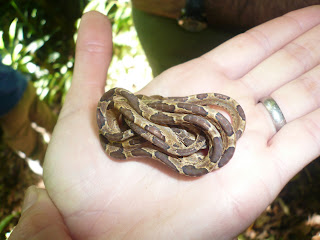Rara Avis (rare bird) was appropriately named as there was indeed a lot of bird life around, however there were also an equal number of snakes about and an even higher number of ticks!
We had to wear wellies - we thought this was because of the mud, but it was really much more to do with protection from the numerous snakes around the trails at the lodge. The second accessory was a walking stick, mostly for poking the undergrowth in front to check for snakes. We were the only recent group not to see a fer de lance http://en.wikipedia.org/wiki/Bothrops_asper, one unlucky English birder even had one rear up at him - luckily the guide came to the rescue and pinned it with his walking stick.
The ultra cute dog with no name met us where the tractor dropped us off - we suspect that despite his cuteness he may well have been chief tick vector.
Offloading some more ticks on an unsuspecting Ralph host.
A tapir skull up at the cabins
A massive orb spider
One of our many guided hikes, they were a bit on the long side with little stopping which made them very difficult for birding. We were vigilant for snakes after 3 other groups had recent encounters, as you can see just about everything we walked over on the path looked like snakes!
A tapir footprint, the closest we got to one, apart from getting their ticks
scarab beetle
The cabins were across a river with a wobbly suspension bridge
There was a great swimming spot at the waterfall that was not quite as alarming as this sign made out
We look a bit like farmers. On arrival at this idyllic swimming spot there was a bullet ant and the biggest spider we'd ever seen on the rocks where we were to get changed, needless to say we declined the opportunity to swim this time.
This eyelash viper was tiny, luckily so were all the snakes we saw (although being small doesn't make them less venomous)
The waterfall was more impressive from this distant viewpoint
A tree fern
A flag footed bug
Some of the birds we saw (not our pics but the trusted interweb)
scarlet thighed dacnis - his colours were unbelievably brilliant but he looks a bit dull her. Ralph thought he looked like magneto out of x-men because of the helmet
oscellated antbird, our guide noticed a carpet of foraging army ants which is always a good place to look for various species of bird which follow the ants around the forest picking off insects which the ants have killed in their path.
king vulture - we only saw this flying so missed out on the fancy giblets!
The presence of Climbing rats in our room was even mentioned in a text book on mammals of costa rica, see above text 'Where to see' and 'habits'. There is also a click beetle on the book.
Double leaved mantis - our guide chased it around the room for half an hour with a broom to get it - much to our dissaproval
Our walk with Jim the guide, Hanneke and Italian father and son photographers. The Italian dad had been on a trip into the Darien gap a notorious no-mans land between Panama and Colombia and came out with 400 ticks on him!! This was a special leaf (which i don't think either of us could now identify) that allows you to leave a message for rescuers should you get lost.
A ridiculously big leech in a river approx 12cm x 5 cm
Jaime our guide on the right, he was entertaining but a bit frantic and mental. He was brilliant at bird song and could recognise many species, yet he didn't wear his glasses so he was less good at pointing out where the birds were. It was the most stressful birding we had ever done, everytime a bird was near he would shouting "THERE, THERE, SEE IT, YOU SEE IT" while waving his arms in a vague direction. The answer was invariably no, at which point he looked quite crestfallen and somewhat dissapointed in us. He was very good at re-enacting through mime his days working on the banana plantations which sounded hideous, carrying huge stems of bananas over his shoulders which as well as being sweltering back breaking work, could be full of either wasps nests, spiders or snakes too.
Dendrobates pumilo or poison dart frog wearing jeans
A salamander
Us and Hanneke braving the bullet ant and enormous spider for a freezing cold dip, very welcome as it was so hot
A group of coati's foraging outside the comedor or canteen
This cicadas body had been overtaken by a parasitic fungus - Yuck!
We did a night walk with Jim through streams in the dark looking for glass frogs and creepy crawlies. This was a bit hair raising as all the books say avoid walking in wet areas in the dark as this is the preferred habitat of the deadly fer de lance snake
glass frog
whiskey frog
Hanneke and Fiona on the night walk, we made our way down the stream very slowly and carefully to avoid any snakes - we didn't see any
A sleeping anole
Check out the antennae on this cricket
This was a massive firefly, I have still failed to manage to take an adequate photo of one glowing
stick insect or walking stick
We think this is a rhinocerous cricket
another crazy insect
huge wolf spider munching down its lunch, a katydid
Rather rashly applied lipstick
A baby boa constrictor
Big seed pod
The main cabin where we had all our meals and did our coati watching. We had our best ever food here. Breakfast is Gallo pinto, rice and beans cooked to perfection!


















































